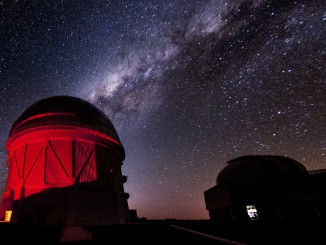
The most widely accepted theoretical scenario for the beginning of the universe is inflation, which predicts that the universe expanded at an exponential rate in the first fleeting fraction of a second. However a number of alternative scenarios have been suggested, some predicting a Big Crunch preceding the Big Bang. The trick is to find measurements that can distinguish between these scenarios.
One promising source of information about the universe’s beginning is the cosmic microwave background (CMB) — the remnant glow of the Big Bang that pervades all of space. This glow appears smooth and uniform at first, but upon closer inspection varies by small amounts. Those variations come from quantum fluctuations present at the birth of the universe that have been stretched as the universe expanded.

While previous experimental and theoretical studies give clues to spatial variations in the primordial universe, they lack the key element of time. Without a ticking clock to measure the passage of time, the evolutionary history of the primordial universe can’t be determined unambiguously.
“Imagine you took the frames of a movie and stacked them all randomly on top of each other. If those frames aren’t labelled with a time, you can’t put them in order. Did the primordial universe crunch or bang? If you don’t know whether the movie is running forward or in reverse, you can’t tell the difference,” explains Chen.
This new research suggests that such “clocks” exist, and can be used to measure the passage of time at the universe’s birth. These clocks take the form of heavy particles, which are an expected product of the “theory of everything” that will unite quantum mechanics and general relativity. They are named the “primordial standard clocks.”
Subatomic heavy particles will behave like a pendulum, oscillating back and forth in a universal and standard way. They can even do so quantum-mechanically without being pushed initially. Those oscillations or quantum wiggles would act as clock ticks, and add time labels to the stack of movie frames in our analogy.
“Ticks of these primordial standard clocks would create corresponding wiggles in measurements of the cosmic microwave background, whose pattern is unique for each scenario,” says coauthor Yi Wang of The Hong Kong University of Science and Technology. However, current data isn’t accurate enough to spot such small variations.
Ongoing experiments should greatly improve the situation. Projects like CfA’s BICEP3 and Keck Array, and many other related experiments worldwide, will gather exquisitely precise CMB data at the same time as they are searching for gravitational waves. If the wiggles from the primordial standard clocks are strong enough, experiments should find them in the next decade. Supporting evidence could come from other lines of investigation, like maps of the large-scale structure of the universe including galaxies and cosmic hydrogen.
And since the primordial standard clocks would be a component of the “theory of everything,” finding them would also provide evidence for physics beyond the Standard Model at an energy scale inaccessible to colliders on the ground.



